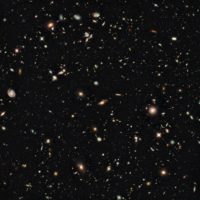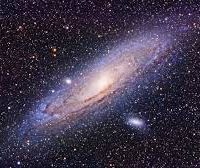The universe is not empty. The Hubble Deep Field, an extremely long exposure of a relatively empty part of the sky, provided evidence that there are about 125 billion (1.25×1011) galaxies in the observable universe (many believe this is a very low estimate). Galaxies started forming within first few hundred million years after the Big Bang and evolved over time to what we see today (13.7 billion years and counting), a wide variety of shapes, sizes, color, and environments.
In the fifth and final presentation in the James Webb Experience, Nimish Hathi, Staff Scientist at the Space Telescope Science, will provide an overview of galaxy formation in the early universe and how galaxies must have transformed across the cosmic time based on the Hubble Space Telescope observations and look ahead at how the upcoming James Webb Space Telescope (JWST) will revolutionize our understanding of the first galaxies, by adding new insights into the physical processes that govern galaxy formation and evolution.
Nimish Hathi is a Staff Scientist at the Space Telescope Science Institute (STScI). He received his PhD in Physics/Astronomy from Arizona State University in 2008. During his PhD studies he worked on distant galaxies in the deepest field observed by the Hubble Space Telescope (HST), the Hubble Ultra Deep Field. After his PhD, he was a post-doctoral fellow at University of California (Riverside, CA), Carnegie Observatories (Pasadena, CA), and Laboratory of Astrophysics in Marseille, France, working on understanding physical properties of distant galaxies and how they evolve with time using space-based and ground-based telescopes. He joined STScI in 2017 as an Instrument Scientist for Hubble’s Advanced Camera for Surveys (ACS). In addition to his current work with HST at STScI, he is actively involved in many science development teams for upcoming space-based (James Webb Space Telescope/JWST, Nancy Grace Roman Space Telescope) and ground-based (Rubin Observatory, Thirty Meter Telescope/TMT, Maunakea Spectroscopic Explorer/MSE) facilities.
NATURAL HISTORY SOCIETY OF MARYLAND (NHSM) has joined almost 500 sites across the country to celebrate the launch of the James Webb Space Telescope, NASA’s next great space science observatory. NHSM will offer a range of public programs beginning October 28 and running through December to bring the excitement of STEAM (science, technology, engineering, arts, and math) to anyone whose favorite words are why, how, and what.
Webb is the largest and most complex space science telescope ever built – the premier observatory of the next decade. This international mission, led by NASA in partnership with the European and Canadian space agencies, will launch in December 2021.
The observatory will provide a new view of the cosmos and push the field of astronomy into a new era. The telescope will observe the universe in the infrared, peering inside dust clouds to study light from distant parts of the universe for the very first time – the first galaxies that formed about 13.5 billion years ago – and give us insight into how our universe formed. It will also explore distant worlds in other solar systems, as well as objects in our own solar system. Webb will extend the scientific discoveries of other NASA missions like the Hubble Space Telescope, Chandra X-ray Observatory, and Transiting Exoplanet Survey Satellite.



